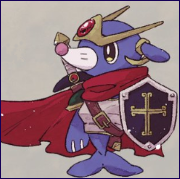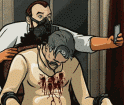|
CodfishCartographer posted:3.Combination of the two ideas: Perhaps this, with a single flip-over-to-wounded side instead of damage? This is low-fiddliness, and also gives you some design space for monsters that behave differently when wounded. It also lets you create "insta-kill" abilities where you kill a monster directly without going to wounded, or special "finisher" abilities that let you sweep up more than one wounded guy or whatever. (But it obviously is problematic if you need uniform card-backs.. though I guess you could just flip them over or something). quote:The obvious thing to cancel out when a monster is engaged is to make it so it wonít advance forward at the end of the round. So then youíre essentially trading health for delaying the timer before you lose. Although, the only time to do that would be if youíre JUST about to lose, so Iím not sure Maybe you take damage from all monsters who are in a given square? Thus you --can-- stop a bunch of monsters on the last space, but you'll get punched by all of them. So often it incentivizes players to you pick out lone monsters, but maybe other times to hassle monsters to clump them up for a big AOE or whatever. Some monsters guard other monsters, whatever... Just thinking out loud, but I think there's a lot of cool design possibilities here. I had a design for a game with some of these things going on (I even went so far as to commission art here). It was "OK" but never got to the point where I really thought it was worth putting out there (the other problem is that Big Book of Madness ended up doing a lot of what I was trying to do, only more streamlined). One other thing I experimented with in a "send out waves of clashing dudes" game was instead of individual monster cards, each mission would have a selection of like, 3 monster cards - on Red Green and Blue backgrounds - and then there was just a flood of little RGB meeples representing individual instances of those monsters running down the path. Instead of damage, they just had a wounded state where their figure was laid down. It was kind of an entertaining little game, but I couldn't make it deep enough to hold interest over time. Anyway, I think there's a good potential game here, and I think you're approaching it on the right terms. Millions of counters will drown a game like this in tedium. jmzero fucked around with this message at 00:20 on Mar 2, 2017 |
|
|
|

|
| # ? May 17, 2024 20:58 |
|
I really like the idea of monsters having a second ďwoundedĒ side! I hadnít considered that, but it definitely opens up a lot of possibilities. Could then design some monsters to not have a wounded side at all, and just die if you match their defense. Iíd need to consider how to handle multiple people attacking one monster, though. Obviously if they match its defense, it gets wounded and flips over. But then what? I guess ďextraĒ damage would carry over and possibly kill it immediately. For example, a monster has 4 defense before being wounded, and 2 defense after. If I have 3 damage I canít wound it, so you join me with 2 damage. We have enough to wound it, but not to kill it afterwards. However, if you had 3 damage too, then weíd immediately kill it without wounding it. Iím still not sure how Iíd handle monsters attacking multiple players, though. Maybe it just hits each player for its attack value? Maybe the players determine how to split up the damage between them? Something else? Right now only one monster can occupy a space at a time, although I suppose I could mess with the systems so that itíd be possible. e: Thinking more about this, I really love this idea and might roll with it. Encourages players to team up to defeat a monster, and also encourages a player to attack a monster even if they canít explicitly kill it, but have enough strength to just wound it. The only thing it really DOESNíT encourage is a player attacking a monster they canít even wound, but then they could just ask another player to give them a hand. And just randomly off the top of my head I can think of some really cool situations: two players teaming up to instantly kill a monster that neither of them could even wound alone, monsters becoming WAY more aggressive when wounded, monsters healing to flip back over, etc. CodfishCartographer fucked around with this message at 01:00 on Mar 2, 2017 |
|
|
|
Yeah, on the healthy side you could have separate wound/instant kill HP thresholds. On the wounded side you could even give them different stats--maybe they're maimed and weaker, enraged and stronger, etc.
|
|
|
|
I agree, the wounded side shouldn't simply be "they took damage", it should change the puzzle in some way. Depending on how deterministic you want the game to be there could even be varying backsides for different monsters of the same type. So for instance, the game might come with four Goblin cards, and when you set up a scenario you choose/arrange them differently - Two of them might become "Cowardly" and get increased movement when wounded and try to disengage players or something, another might be "Frenzied" and deal more damage, and the last could be "Devious" and call for help from an adjacent big boy monster.
|
|
|
|
CodfishCartographer posted:I’m still not sure how I’d handle monsters attacking multiple players, though. Maybe it just hits each player for its attack value? Maybe the players determine how to split up the damage between them? Something else? You could do both - have 'the monster deals it's base damage (or half base damage) to all players' as the default rule, with players able to gain 'split all damage targeting you and another player however you choose' as a special ability. Or allow players to split damage most of the time, with particularly nasty monsters overriding that with a special ability that auto-asigns damage.
|
|
|
|
CodfishCartographer posted:Thanks for the tips! I hadnít really considered an effect that gets disabled when engaged. How the game works is that there are 9 slots leading up to a village, with <# of players -1> monsters being added to the open slot(s) farthest from the village at the end of every round, and then whichever monster is closest to the village moves forward 1 slot. If ever a monster gets to the village, or there are no open slots when a monster is added, the players lose. What if you "expand" the village to take up more tiles? Losing the final tile should lose the game, but then the players should still have incentives to stop monsters from taking the earlier tiles, either because they will lose some bonus (warning, death spiral), or because it will count negatively in their final score.
|
|
|
|
CodfishCartographer posted:I really like the idea of monsters having a second ďwoundedĒ side! I hadnít considered that, but it definitely opens up a lot of possibilities. Could then design some monsters to not have a wounded side at all, and just die if you match their defense. Iíd need to consider how to handle multiple people attacking one monster, though. Obviously if they match its defense, it gets wounded and flips over. But then what? I guess ďextraĒ damage would carry over and possibly kill it immediately. For example, a monster has 4 defense before being wounded, and 2 defense after. If I have 3 damage I canít wound it, so you join me with 2 damage. We have enough to wound it, but not to kill it afterwards. However, if you had 3 damage too, then weíd immediately kill it without wounding it. Theres a FFG game that uses a mechanic similar to this called Warhammer 40k: Conquest. Your general has certain abilities they can use on the tile (planet) they are on that give bonuses or allow your troops to move in unconventional ways. After the generals have taken a certain amount of damage, they retreat to their home base and are flipped to their wounded side. The wounded side has similar abilities but they are less powerful, as well as having a smaller health total and a lower attack value. The only problem I have with the game is the amount of tokens needed to track damage. It's only a two player game, but it gets pretty ridiculous sometimes! Despite that, it's a pretty neat system, and you might want to see if you can find the rules/a cheap copy on ebay if you want to check it out for inspiration.
|
|
|
|
Hey, new board game designer here. I made a wish on a monkey's paw for an entry-level paid position, but right about now I'm running up against all those ironic twists. Mostly centered around my boss and his management style, as well as his insistence on NDAs. But there's other places to talk about interpersonal relations, the big problem I can tackle now is Solo Testing. I have a few people I can bounce ideas off of, but they tend to tear apart new mechanics and suggest their own before I have a firm set of rules written and a chance to see how they really play. If anyone could share some tips for running through a game on your own in a way that produces useful "feedback" I'd be deeply thankful.
|
|
|
|
|
Triskelli posted:Hey, new board game designer here. I made a wish on a monkey's paw for an entry-level paid position, but right about now I'm running up against all those ironic twists. Mostly centered around my boss and his management style, as well as his insistence on NDAs. But there's other places to talk about interpersonal relations, the big problem I can tackle now is Solo Testing. I have a few people I can bounce ideas off of, but they tend to tear apart new mechanics and suggest their own before I have a firm set of rules written and a chance to see how they really play. If anyone could share some tips for running through a game on your own in a way that produces useful "feedback" I'd be deeply thankful. Thereís always the option of just playing a game where youíre controlling all the players yourself, but I kind of assume youíve done that, and obviously it isnít a super accurate version of the game. Can you wrangle in any coworkers to help playtest? I assume theyíd be under the same (or similar) NDA as you are, so itíd be easier for you to be up-front with the design. e: as for a more real answer to your question, there really isnít a perfect way to test completely solo. You can try as many different strategies and playstyles as you can think of, and purposefully try to break it as hard as possible, but there will be situations that you just canít imagine on your own. Thatís not even accounting for rules that make sense to you but nobody else, or that break when played in a way you havenít considered, etc. If your boss wonít let you playtest with others then you really just kind of need to do your best with this, unfortunately. Iíd say maybe ask friends questions as vaguely as you possibly can to try and get creative answers? Something maybe like ďyouíre playing a game with a timer on it, and you can push the timer back up, when the timer runs out something bad happens, what does the timer represent?Ē or whatever. CodfishCartographer fucked around with this message at 17:18 on Mar 2, 2017 |
|
|
|
Thanks for the response! Yes, I have one co-worker that I can rely on to sit down and talk out ideas with, but I've made significant, sweeping changes over the last 3 weeks or so. Every time I sit down with him or my boss I have basically a new game to run through, with rules in my head that haven't been committed to paper. And while I get invaluable feedback, they are also giving me radically different solutions to problems they're guessing might show up after sitting through only a few turns. I can't get them to just sit down and play this game, instead of the ones they've got in their heads.
|
|
|
|
|
Triskelli posted:Thanks for the response! Yes, I have one co-worker that I can rely on to sit down and talk out ideas with, but I've made significant, sweeping changes over the last 3 weeks or so. Every time I sit down with him or my boss I have basically a new game to run through, with rules in my head that haven't been committed to paper. And while I get invaluable feedback, they are also giving me radically different solutions to problems they're guessing might show up after sitting through only a few turns. I can't get them to just sit down and play this game, instead of the ones they've got in their heads. Hrmm, that does sound a little annoying. any chance you can convince your boss to allow some outside friends of yours to come in and sign an NDA to help test? Iím not sure legally how that would work without paying them somehow, but it might be possible. Hopefully someone else has some more advice on solo testing, unfortunately I havenít got much experience with solo testing beyond early stages of a game.
|
|
|
|
People, I need help. As a mentioned a few posts earlier, I am working on a co-op dungeon crawler kind of game. To be honest with you, I have been raised on a steady diet of DnD ever since I was in high school, and I find it really hard to detach myself from it's wargaming model for dealing with battles. Maybe "wargaming model" is not the right term because there are just so many wargames out there, but I used it to point out that the way it works has it's roots in Chainmail than something that was made specifically for DnD. Basically the system has the following components:
Now, this system has some obvious advantages, the one I really want to focus on being that it necessitates teamwork. It's extremely important to focus fire, because usually a single player's attack action is not enough to take out an enemy, and reducing the number of enemies reduces the overall threat. A party whose members just randomly attack whomever they want will not be that effective. It's a system that works, and there are definitely games that have implemented it in ways that allow for tactical depth (that is, requiring tactics that are not as obvious as just focus firing), but in the end for me what it evokes is less of the heroic struggle I see in stories and more of a clinical approach to warfare. There must be tactical crunchiness in a different paradigm. First I think I really need to untangle the concept of "threat" from the "opportunity to reduce threat". Why should an orc have "hit points"? If you strike down an orc, and another one takes it's place, what difference did you make? It matters in wargames, but does it matter in heroic tales? But killing an orc who is about to strike your friend from behind is definitely a meaningful act of overcoming a threat, even if it didn't bring you closer to victory. Maybe there is a different point of interaction that makes the victory timer tick that requires the expenditure of player resources, and needs to be balanced against the resources needed to overcome the threats that drive the defeat timer. I am absolutely sure I am not the first person to have this problem, and if what I described made you think of a game that tried to work a solution to it, I need you to tell me about it. I desperately need inspiration. In the end, I might as well go down the wargaming road (my game's differentiating gimmick does not depend on either solution), but I want to try something else first.
|
|
|
|
CodfishCartographer posted:So, need some thoughts / advice on how to deal damage to enemies in a game I'm designing. Right now the game is setup so there can be up to 6-9 enemies on the board at once, represented by cards. When a player sets their figure on a card, theyíre ďengagedĒ with that monster, and will deal damage to and take damage from it. Monster cards can sometimes move, usually only one per round but sometimes two or more. I have a few ideas for how it could work: If you want to avoid monster tokens, you could resolve each fight in one go. If the player doesn't kill the monster, they hit each other again until the monster dies. So if the monster's stats are 2/5 and the player has 3 attack, the player will take 4 damage in the 2 rounds they need to kill the monster. Two players would only need 1 round to kill the monster, so they'd only take damage once. Still need to figure out how to split the damage among players. Maybe the player with the most attack/health would take all the damage? On the other hand, the wound system could work very well, too.
|
|
|
|
So I'm speaking with my first publishers! I ended up with 3 interested publishers after the NY Toyfair and the first just responded back with some questions. I really don't know what to expect at this point though so any help from you guys would be great! The first question the publisher asked me is if the placeholder art/layout on my test game was "final". I mean, it's clearly not, but I also though a publisher would be responsible for art assets? Its this not the case?
|
|
|
|
Balon posted:So I'm speaking with my first publishers! I ended up with 3 interested publishers after the NY Toyfair and the first just responded back with some questions. I unfortunately can't answer a lot of questions about this, but hopefully this can.
|
|
|
|
Xom posted:I made a thing like nanDECK. Now what I really need is real users, which will help me figure out what improvements I should focus on. Any feedback is welcome. 
|
|
|
|
Xom posted:I redesigned the workflow. Now you put your template in a HTML file that also includes the paths to Cardery.js and to your CSV. This looks cool. I was checking out nanDECK for my card-making needs but yours seems viable too. Can you say a little about this program's advantages over nanDECK?
|
|
|
|
Cardery's main advantage is that you write templates in HTML/JS/CSS instead of some obscure language. Cardery's main disadvantage is that, because it relies on your browser and OS to do the heavy lifting, what you write may not be portable between computers. For example, in writing the demo I was in the peculiar situation of needing it to look good everywhere, but not necessarily look the same everywhere. The demo specifies "font-family: sans-serif" and lets the browser choose the exact font. I did try specifying "font-family: Verdana", which is my default font in Chrome, but in Firefox the kerning became hideous when Cardery applied CSS scale() (thankfully the issue is font-specific, and it looks fine with my default font Open Sans). I will try Cardery in a Linux VM and see if the rendering looks reasonable. If so, then that becomes one answer to the portability issue. The other advantage of Cardery is, if you are literally my first user, then I will write the template if you supply the graphic design.
|
|
|
|
Xom posted:The other advantage of Cardery is, if you are literally my first user, then I will write the template if you supply the graphic design. Might take you up on that! I'm designing a COIN game set in the Cold War, and I'll have to figure out card details soon. (Right now I only have names and general effects for the cards.)
|
|
|
|
dhamster posted:It's being judged over a period of about a month, I will find out mid-March how it did. Pretty anxious to find out! So, I didn't win, but I am still pretty proud of the game I made. At the 'grand exhibition' event several people stopped by to play. For a decent stretch, both of my copies of the game were seeing play at the same time. Many players stayed for two or more games to have a rematch or try other characters, and it seemed like they were having fun, and able to pick it up without much trouble. I did notice some misprints that slipped by me the first time around, but I'll fix that on the next run. Anyway, I'll let you guys know if I release this in some form (TTS or PnP, most likely). My graphics guy made us a website, but there isn't really anything on it yet besides the rules.
|
|
|
|
I wanted to ask some actual designers about psychology versus statistics. So to sum up, my game currently has rock-paper-scissors d6, with each player getting one that's evenly balanced and one each that's loaded towards Rock, Paper, or Scissors. I'm currently running with the idea that each of the dice are unbalanced in the same directions, but I'm torn between having a 3/2/1 balance or a 4/1/1 balance. I'm ruling that ties are rerolled, and that a die battle is rolled until there are X victories for either the attacker or the defender. Assuming the Defender is able to defend with the appropriate die, they're looking at a 66% chance of victory on the 4/1/1 die, and a 55% chance of victory on a 3/2/1 die. The die being 3R/2S/1P or 3R/2P/1S doesn't affect the overall probabilities. Which is where my decision comes in. After playing through a game with a game with 4/1/1, the defending player was too strong, as they were likely to have the dice they needed. But playtesters on both versions of the 3/2/1 dice complained that the attacker or defender felt too strong. A big part of that may have to do with the wooden blocks I'm using instead of proper dice, but I don't want to rule out the placebo effect, and the expected outcomes of the dice. ...Yeah that got a little rambly, my ultimate question is that despite a 55% victory chance either way on 2d6, why would one player feel they have more of an advantage with one pair of dice than another pair?
|
|
|
|
|
Do the players get to choose which dice they have, or is it always going to be an even distribution? By that I mean, can two players have 3R/2P/1S dice? Also, do players roll both dice, or choose which die they want to roll? Anyways, itís likely a mix of the actual statistics and confirmation bias. Players expected with a 4/1/1 to have an easier time defending, so every time they lost while attacking it felt like it was always because of the extra 11% chance. Vice versa with the 3/2/1 die - every time an attacker won, it felt like it was because they lost that 11%. However, the overall impact of this may not necessarily be in line with the playersí expectations: despite players feeling attack/defense was stronger, did the actual game prove that? Were the attackers the stronger players, or did it just feel like they were? As for solutions, the first that springs to mind is that you could possibly rework how draws work - maybe go with a 3/2/1 die, and then defenders win ties.
|
|
|
|
Triskelli posted:...Yeah that got a little rambly, my ultimate question is that despite a 55% victory chance either way on 2d6, why would one player feel they have more of an advantage with one pair of dice than another pair? My guess: 55% is still basically coinflip territory, so the results will be fairly evenly distributed to the human eye, but when people can see that the odds are clearly not equal they'll read more into that than they should. If they lose a bunch of fights they had a slight advantage on it feels too weak (because they "know" they have an advantage and are supposed to mostly win) and if they win a bunch of fights they had a slight advantage on it feels too strong (they "know" they had an advantage so how was the opponent supposed to compete?), even though both results are well within the realm of possibility.
|
|
|
CodfishCartographer posted:Do the players get to choose which dice they have, or is it always going to be an even distribution? By that I mean, can two players have 3R/2P/1S dice? Also, do players roll both dice, or choose which die they want to roll? No player will ever get more than their Balanced, Rock, Scissor, or Paper die. Players choose one of these four dice to send an "attack" to another player, which could cause 3-8 dice rolls between the attacker's die and the defender's choice of dice they still have at home. Depending on the size of your attack, your die could take up to three turns to return to you. This leads to more light raids and making sure you have all four dice available as often as possible, and waiting for a hand of action cards to tip the scales in your favor. Which is fun! But in a sense it makes the "attack track" a redundant feature (for 2P games at least). CodfishCartographer posted:As for solutions, the first that springs to mind is that you could possibly rework how draws work - maybe go with a 3/2/1 die, and then defenders win ties. That's my instinct too, but some napkin math shows that if the defender wins ties and is able play the right counter then they're looking at a 70% win rate compared to an ideal attacker squeaking by with an attacker's 39% in ideal conditions. So after running through the game with my boss again we've managed to spawn yet another new idea and/or new direction for this game. This is my first month as a game designer, and while I'm following the beginner's guides from the thread I'm having trouble balancing the learning process with making sure I'm showing visible progress. Definitely thank you guys for your responses so far, but I think the question I NEED to ask is what big-picture things am I missing? Not for this specific game, but for designing any board game? Please ask me questions about my situation too: I really need to temper my boss's expectations about what can be done in a given timeframe. Triskelli fucked around with this message at 22:16 on Mar 14, 2017 |
|
|
|
|
Hey guys I'm putting together a simple little game just for me and some friends to play using lego. It's sort of like catan meets civ. Build up cities, harvest resources, and mechanics that reward trade and cooperation. I have a lot of experience and exposure to economic/trading games but not combat games. Risk and Axis and Allies is about my extent. There's going to be simple combat in the game, I'd like to make it a little more interesting/involved than Risk. Does anyone have any ideas of games to look at for "inspiration" or have any direct suggestions? Right now it's just line up armies and roll dice like in Risk. I'd love something where the players have a bit more meaningful choices to make on abstracted tactics or their army composition, and have most units that "lose" more realistically fall back rather than just vanish off the board. Generally you don't fully destroy an army or division in a single battle. Baronjutter fucked around with this message at 22:10 on Mar 14, 2017 |
|
|
|
Any statisticians or coders board at work? Trying to determine outcome variance for a combat system. - both players roll 5 d6 - matching a die value removes all dice of that value from the opponents pool Ex: results of a sample conflict, player one rolls 1,1,3,4,4 player 2 rolls 1,2,3,5,5 result is player 1 scores 2 success (both 4s) and player 2 scores 3 successes (both 5s and the 2) what I am trying to set is the results of ties, winning by 1 success and winning by more than 1 success so given 1000s roll offs: - how many times would the players have the same number of success - how many times does a player have 1 more success than the other - how many times does a player have 2+ success more than the other If all that makes sense. Basically if ties are most common, this would be the "push" result, maybe going to a tie breaker of highest value success die. but if a player generally gets 1 more success than the other no tie breaker is needed.
|
|
|
Baronjutter posted:Hey guys I'm putting together a simple little game just for me and some friends to play using lego. It's sort of like catan meets civ. Build up cities, harvest resources, and mechanics that reward trade and cooperation. I have a lot of experience and exposure to economic/trading games but not combat games. Risk and Axis and Allies is about my extent. Clash of Cultures is a similar game to what you're trying, and has a nice compromise on the systems you're familar with. In summary, each army dude gives you one d6. You roll all your dice and add up the total, then divide by 5 to get your "hits". So say you have two armies of 3 dudes facing off: One person rolls an 8 (2,2,4) and gets 1 "hit", while the other rolls a 12 (5, 3, 4) for 2 hits. Those hits are assigned to each army, so you're left with an army of one and an army of 2 after the first round. Battles continue until one person surrenders or one side is eliminated. There's a number of action cards and techs that either "block" hits, give a guaranteed hit, or affect the number rolled on the dice. Overall more tactical than either Axis & Allies or Risk while not being terribly more complicated.
|
|
|
|
|
Mr.Booger posted:Any statisticians or coders board at work? Here's the distribution by difference in score: (0): 335 (1): 453 (2): 186 (3): 25 (4): 1 (5): 0
|
|
|
|
Wow, that was fast, thanks a ton!
|
|
|
|
Baronjutter posted:Hey guys I'm putting together a simple little game just for me and some friends to play using lego. It's sort of like catan meets civ. Build up cities, harvest resources, and mechanics that reward trade and cooperation. I have a lot of experience and exposure to economic/trading games but not combat games. Risk and Axis and Allies is about my extent. IMO Scythe has some really cool ideas for combat in an economic-oriented 4X. If you're not familiar, a quick rundown: each player only ever has a small handful of military pieces on the board. Pieces don't actually have intrinsic military strength--building units unlocks new military capabilities, and you can move pieces around to represent area control, but the pieces themselves are just containers for players to spend military resources on in battle. Each player has a general resource pool of "power" that represents their military reserves, plus they can accumulate combat cards that can be spent for one-time bonuses; when combat happens, each player just decides how many points of power to spend from their pool, modified by whatever combat cards they play (which are all just basic numerical addition.) That's it, your actual military pieces are just there to mark territory control--how many you have in the combat only matters as a cap on the number of combat cards you can play, but cards are relatively expensive so dropping multiple cards is a pretty huge play. They're never destroyed, either, just pushed around: your losses are represented by the power and cards you spent on the battle. It's a great implementation of the "combat as an extension of economy" idea that most 4X games revolve around, without the fiddly parts of moving around a million little pieces and rolling fistfuls of dice.
|
|
|
|
Straight White Shark posted:IMO Scythe has some really cool ideas for combat in an economic-oriented 4X. If you're not familiar, a quick rundown: each player only ever has a small handful of military pieces on the board. Pieces don't actually have intrinsic military strength--building units unlocks new military capabilities, and you can move pieces around to represent area control, but the pieces themselves are just containers for players to spend military resources on in battle. Now this has me thinking! I want something that won't clutter the board, I want the player to have reserves, and I want war to cost money, both to win and lose. But what's to stop someone from just putting all their power where they need it? Cost? In my game a "turn" probably represents a quarter or even a year, which honestly is more than enough time for a modern or future army to get anywhere on a planet. Buying a deck of cards representing units, techs, and abilities you have in reserve sounds cool. Some could be single use (like a strategic missile barrage), some free to play (like your basic militia and reserves), some cost to deploy but go back into the reserve (like expensive airforce or armoured units) The problem with going card based though is, well, the cards. This is a lego game. Sure I'm using monopoly money and plastic counters for resources, but I hope to not need to print a ton of cards with cool art on them to play. To just have little lego bricks or what ever represent most things. It's all stuff to think about. The general idea that your on-map army marker is just a token for representing where you can or will be deploying your actual forces is good though. Baronjutter fucked around with this message at 23:31 on Mar 14, 2017 |
|
|
|
Baronjutter posted:Now this has me thinking! I want something that won't clutter the board, I want the player to have reserves, and I want war to cost money, both to win and lose. But what's to stop someone from just putting all their power where they need it? Cost? In my game a "turn" probably represents a quarter or even a year, which honestly is more than enough time for a modern or future army to get anywhere on a planet. Buying a deck of cards representing units, techs, and abilities you have in reserve sounds cool. Some could be single use (like a strategic missile barrage), some free to play (like your basic militia and reserves), some cost to deploy but go back into the reserve (like expensive airforce or armoured units) You could try designing the game to where a standard 52 playing card deck could work, if designing + printing cards isnít something you want to bother with. As for what keeps players from dumping all their power when itís needed; if I remember right (itís been a while since I played Scythe) itís actually quite difficult to generate power, and using it all up at once will mean basically everyone else can shove you around as they want. Scythe uses armies more like nuclear weapons, with mutually assured destruction. If you attack someone, it could have VERY dire consequences for you, so it better drat well be worth it.
|
|
|
|
I just spent $90 buying bulk lego bricks of various sizes and shapes to give me more options in designing a game I don't even know if I'll finish or like. What the hell.
|
|
|
|
I went to a pretty good board game design panel at PAX this past weekend, and there was a lot of talk about prototyping and design constraints. It was pretty interesting stuff, including talking about how a lot of really popular board game designers tend to put almost no effort into their prototypes. Granted, this is specifically for designing games and presenting them to publishers to have them take that aspect over, but still. Something I will definitely be keeping in mind.
|
|
|
|
Yeah, there is a huge temptation to just blast through the actual designing and have something that looks nice (by homemade board game standards) when people first start getting into game design. That's not necessarily a bad thing, we are visual creatures after all, but when you're staring at a webpage clicking add to cart on that one set of color coordinated cowboy pieces that you totally need, it's time to take a step back and really look at what you're doing. I've fallen into that trap probably more times than I'm willing to admit. On a slightly humorous note, one of my game designer friends told me that when you start getting complaints about the lack of art more than you are about the rules is when you should start thinking about art assets. Anyway, I recently held a playtest for Porteur with some friends and I think it's really starting to shape up into something good! Having two separate decks of event cards bogged the game down a little too much, so I streamlined much of the game and added some challenges to the board. All changes have been added to the rules document if anyone would like to take a look: https://docs.google.com/document/d/1PqmektAa6OtO_SV7i5ktyrgegvybqNGefdTAt2rVDg4/edit Feel free to leave a comment on it! I'm no writer, so I'm sure some things that make sense to me don't read well to others and could use some editing. Chip McFuck fucked around with this message at 19:35 on Mar 23, 2017 |
|
|
|
Hi again thread. Still grappling with the whole "becoming a game designer" thing for a local tech startup, but I've finally managed to grab my bosses' ear for a presentation on the IP protection side of boardgames and I'm presenting tomorrow. He wants every possible protection for our ideas, while I want to move to blind/community playtesting as soon as possible (in 2 weeks at max). I have the info I need for how patents, copyrights, trademarks, and NDAs play into the industry; but I decided to add a segment called "So Someone Stole our Idea - What Now?", and am running into a bit of a wall trying to fit the struggles involved with getting a game "sold" before a company could manage to do it. So if anyone feels like sharing, how did you/how are you planning to get your game published, and how long did it take you to get money for a "ready to sell" prototype?
|
|
|
|
|
So, Iíve ran into a bit of a scaling problem with the game Iím working on now, anyone have any advice? Right now, the game is about defeating waves of enemies. When you beat all the enemies, you win, hooray. Enemies are represented by cards in a deck, and are divided into three waves of increasing difficulty. Each round, <# of players -1> enemies are added from the deck to the board. So 2 players add 1 monster, 3 players add 2 monsters, etc. The problem has come up that with 3-4 players, the game goes too quickly because the monsters get added to the game much faster. With 2 players Iíve hit a sweet spot of around 27 monsters total - 3 waves of 9 monster each. Even that might be a bit too few, though. While that means 27 rounds, in a 4 player game it means only 9 rounds of gameplay through the whole game. The obvious answer is to just scale up the number of monsters in each wave depending on the number of players, but then that means in a 4 player game, the deck would need 81 cards to get to the same number of rounds as a 2 player game, and holy poo poo thatís a lot of cards for a single deck. Also, I need to keep in mind that more players = longer rounds. With 2 player testing I estimated each round takes about 80 seconds, and Iím not sure how much that scales up for 4 players. I feel like I should probably try to time roughly how much each round takes with 4 players, then scale it based off of THAT, but Iíd like to address the core issue more, so itís not just bandaiding the problems. It feels like the core problem stems form the win condition being tied to defeating all the monsters, which means itís limited by a physical component (number of cards in a deck), but Iím not sure how to rework things to create an entirely new win condition. Anyone have any thoughts?
|
|
|
|
How much variety do you have already? Is it possible to reuse the cards?
|
|
|
|
Got back into working on my civ/catan style game using lego bricks. Still having trouble coming up with a good system that takes advantage of the terrain types and achieves spacing on the cities. In civ your cities could work 20 tiles around it in a "fat cross" shape and cities with overlapping ranges could obviously only have 1 city work a single tile. I want something like that where you place down your cities and they take advantage of the terrain around them, and that you need a buffer between cities in order to "work the land" and support them selves. But I also don't want the game to require you to be counting up 50+ tiles or having to place some sort of marker on every single tile showing if a tile is being worked or not or which city "owns" it.
|
|
|
|

|
| # ? May 17, 2024 20:58 |
|
Kashuno posted:How much variety do you have already? Is it possible to reuse the cards? You know, IÖnever actually thought of that  I suppose I could just say players need to repeat each wave depending on the number of players, but that might get a teensy bit repetitive. I'll keep that in mind, but try to think of some alternatives. I suppose I could just say players need to repeat each wave depending on the number of players, but that might get a teensy bit repetitive. I'll keep that in mind, but try to think of some alternatives.I also am now realizing I tied the pacing of upgrades players earn to the number of monsters defeated, so scaling up the number of monsters will totally gently caress that up. Hmm.
|
|
|


























